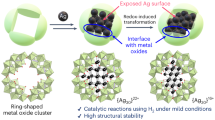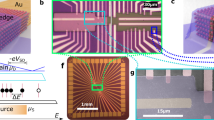Abstract
Metal nanoparticles supported by thin films are important in the fields of molecular electronics, biotechnology and catalysis, among others. Penetration of these nanoparticles through their supporting films can be undesirable in some circumstances1 but desirable in others2,3,4, and is often considered to be a diffusive process. Here, we demonstrate a mechanism for the penetration of thin films and other nanoscopic barriers that is different from simple diffusion. Silver clusters that are soft-landed onto a monolayer of C60 supported by gold sink through the monolayer in a matter of hours. However, the clusters are stable when landed onto two monolayers of C60 supported on gold, or on one monolayer of C60 supported on graphite. With backing from atomistic calculations, these results demonstrate that a metallic substrate exerts attractive forces on metallic nanoparticles that are separated from the substrate by a single monolayer.
This is a preview of subscription content, access via your institution
Access options
Subscribe to this journal
Receive 12 print issues and online access
$259.00 per year
only $21.58 per issue
Buy this article
- Purchase on Springer Link
- Instant access to full article PDF
Prices may be subject to local taxes which are calculated during checkout




Similar content being viewed by others
References
Chen, Y., Palmer, R. E. & Wilcoxon, J. P. Sintering of passivated gold nanoparticles under the electron beam. Langmuir 22, 2851–2855 (2006).
Lau, C. N., Stewart, D. R., Williams, R. S. & Bockrath, M. Direct observation of nanoscale switching centers in metal/molecule/metal structures. Nano Lett. 4, 569–572 (2004).
Ssenyange, S., Yan, H. & McCreery, R. L. Redox-driven conductance switching via filament formation and dissolution in carbon/molecule/TiO2/Ag molecular electronic junctions. Langmuir 22, 10689–10696 (2006).
Jo, S. H. & Wei Lu, W. CMOS compatible nanoscale nonvolatile resistance switching memory. Nano Lett. 8, 392–397 (2008).
Duffe, S. et al. Softlanding and STM imaging of Ag561 clusters on a C60 monolayer. Eur. Phys. J. D 45, 401–408 (2007).
Rohrer, C. & Wegscheider, W. The atomization of silver in graphite furnace atomic absorption spectrometry—a Monte Carlo study of physical parameters. Spectrochim. Acta 48B, 315–329 (1993).
Sommerfeld, A. & Bethe, H. in Handbuch der Physik Vol. 24–2 (Springer, 1933).
Simmons, J. G. Generalized formula for the electric tunnel effect between similar electrodes separated by a thin insulating film. J. Appl. Phys. 34, 1793–1803 (1963).
Lando, A. Lauwaet, K. & Lievens, P. Controlled nanostructuring of a gold film covered with alkanethiol SAM by low energy cluster implantation. Phys. Chem. Chem. Phys. 11, 1521–1525 (2009).
Elechiguerra, J. L. et al. Interaction of silver nanoparticles with HIV-1. J. Nanobiotech. 3, 6 (2005)
Haberland, H. et al. Filling of micron-sized contact holes with copper by energetic cluster impact. J. Vac. Sci. Technol. A 12, 2925–2930 (1994).
von Issendorff, B. & Palmer, R. E. A new high transmission infinite range mass selector for cluster and nanoparticle beams. Rev. Sci. Instrum. 70, 4497–4501 (1999).
Hövel, H. et al. High-resolution photoemission combined with low-temperature STM. J. Electron Spectrosc. Relat. Phenom. 88, 1015–1020 (1998).
Liu, H. & Reinke, P. C60 thin film growth on graphite: coexistence of spherical and fractal-dendritic islands. J. Chem. Phys. 124, 164707 (2006).
van de Leemput, L. E. C., Rongen, P. H. H., Timmermann, B. H. & van Kempen, H. Calibration and characterization of piezoelectric elements as used in scanning tunneling microscopy. Rev. Sci. Instrum. 62, 989–992 (1991).
Liu, S., Lu, Y.-J., Kappes, M. M. & Ibers, J. A. The structure of the C60 molecule: X-ray structure determination of a twin at 110 K. Science 254, 408–410 (1991).
Hövel, H. Clusters on surfaces: high resolution spectroscopy at low temperatures. Appl. Phys. A 72, 295–302 (2001).
Sutton, A. P. & Chen, J. Long-range Finnis–Sinclair potentials. Phil. Mag. Lett. 61, 139–146 (1990).
Brenner, D. Empirical potential for hydrocarbons for use in simulating the chemical vapour deposition of diamond films. Phys. Rev. B 42, 9458–9471 (1990).
Girifalco, L. A. Molecular properties of C60 in the gas and solid phases. J. Phys. Chem. 96, 858–861 (1992).
Wang, L.-L. & Cheng, H.-P. Density functional study of the adsorption of a C60 monolayer on Ag(111) and Au(111) surfaces. Phys. Rev. B 69, 165417 (2004).
Park, H. et al. Nanomechanical oscillations in a single-C60 transistor. Nature 407, 57–60 (2000).
Mortensen, J. J., Hansen, L.B. & Jacobsen, K.W. Real-space grid implementation of the projector augmented wave method. Phys. Rev. B 71, 035109 (2005).
Acknowledgements
We thank the Deutsche Forschungsgemeinschaft (DFG) for funding within the priority program SPP 1153.
Author information
Authors and Affiliations
Contributions
S.D., N.G., L.P., B.S. and H.H. conceived, designed and performed the experiments and analysed the data. C.Y. and B.v.I. conceived and designed the cluster machine and took part in the experiments. M.M. performed the atomistic calculations. All authors discussed the results and commented on the manuscript.
Corresponding author
Ethics declarations
Competing interests
The authors declare no competing financial interests.
Supplementary information
Supplementary information
Supplementary information (PDF 861 kb)
Rights and permissions
About this article
Cite this article
Duffe, S., Grönhagen, N., Patryarcha, L. et al. Penetration of thin C60 films by metal nanoparticles. Nature Nanotech 5, 335–339 (2010). https://doi.org/10.1038/nnano.2010.45
Received:
Accepted:
Published:
Issue Date:
DOI: https://doi.org/10.1038/nnano.2010.45
This article is cited by
-
Al13− and B@Al12− superatoms on a molecularly decorated substrate
Nature Communications (2022)
-
Catalysis by clusters with precise numbers of atoms
Nature Nanotechnology (2015)
-
Activity of palladium nanoparticles on graphene oxide in the Suzuki—Miyaura reaction
Russian Chemical Bulletin (2012)



